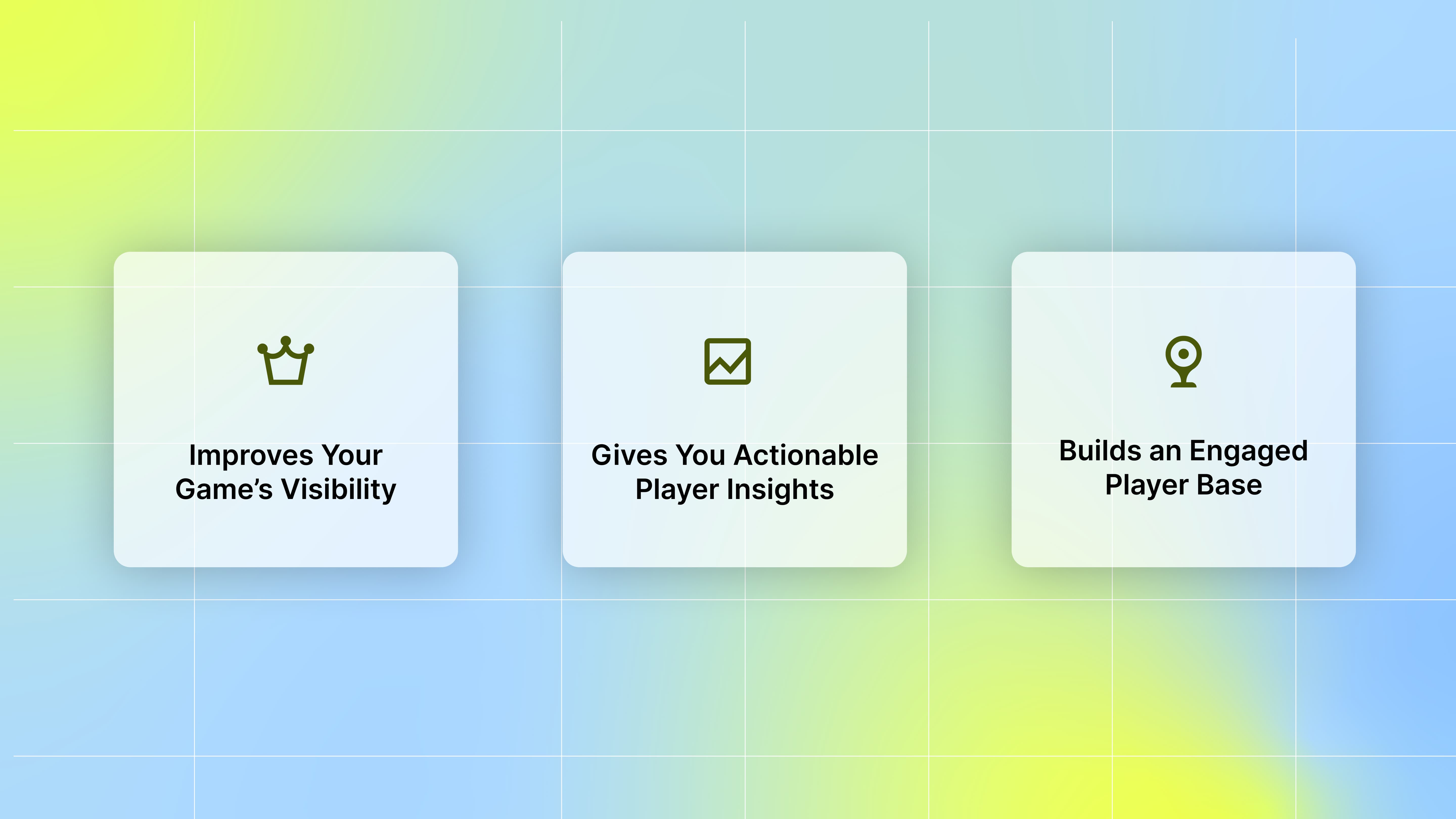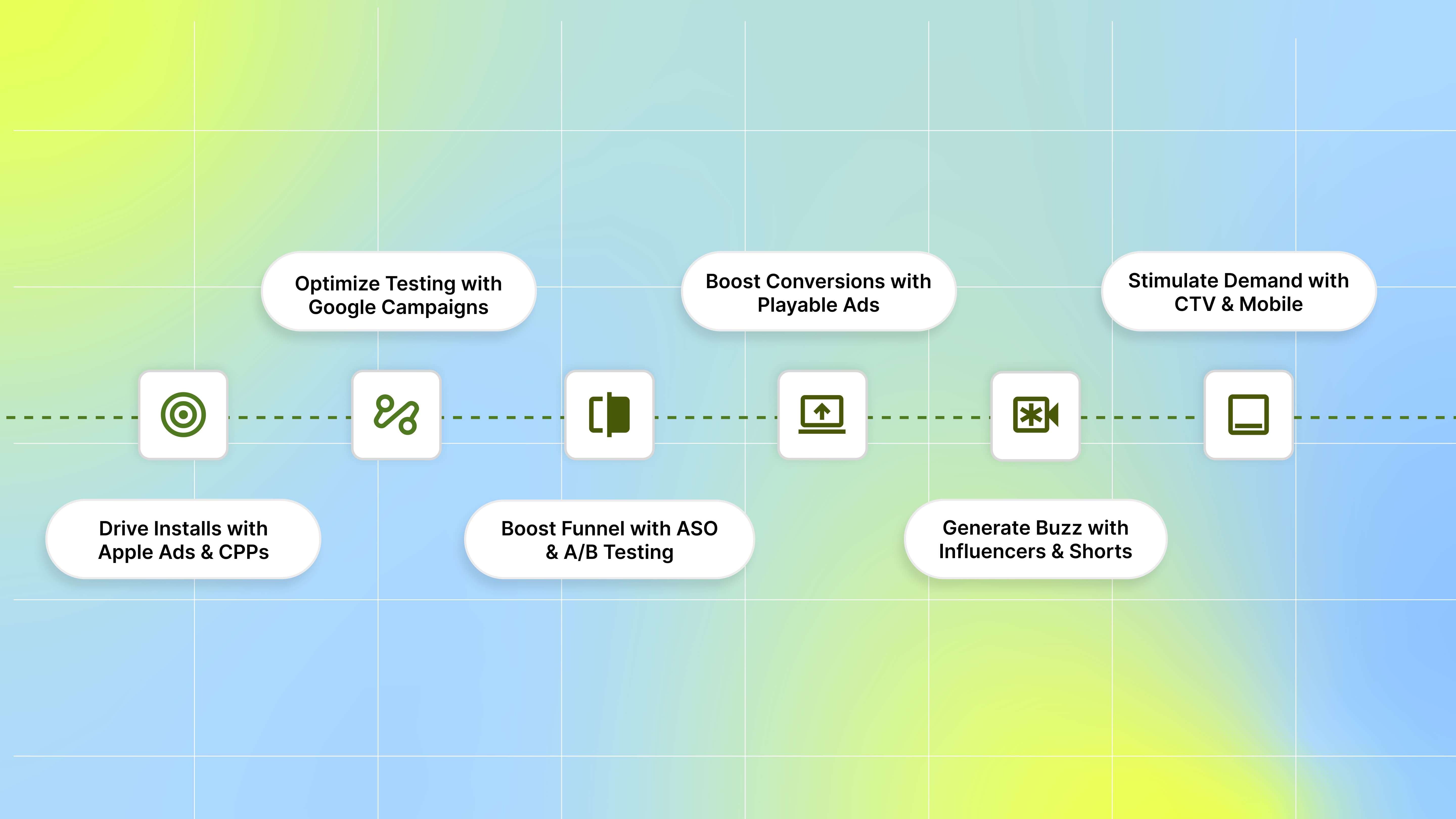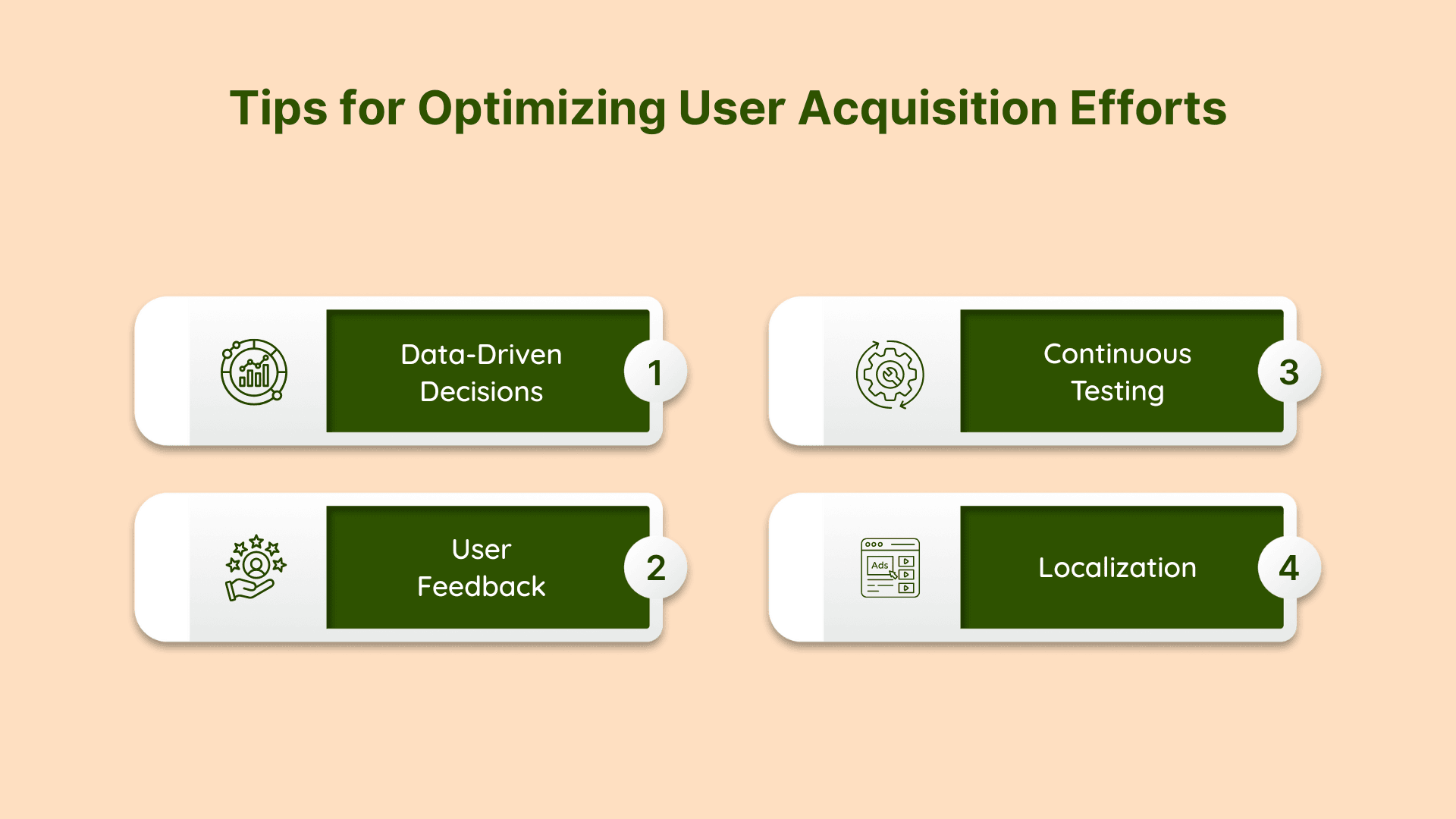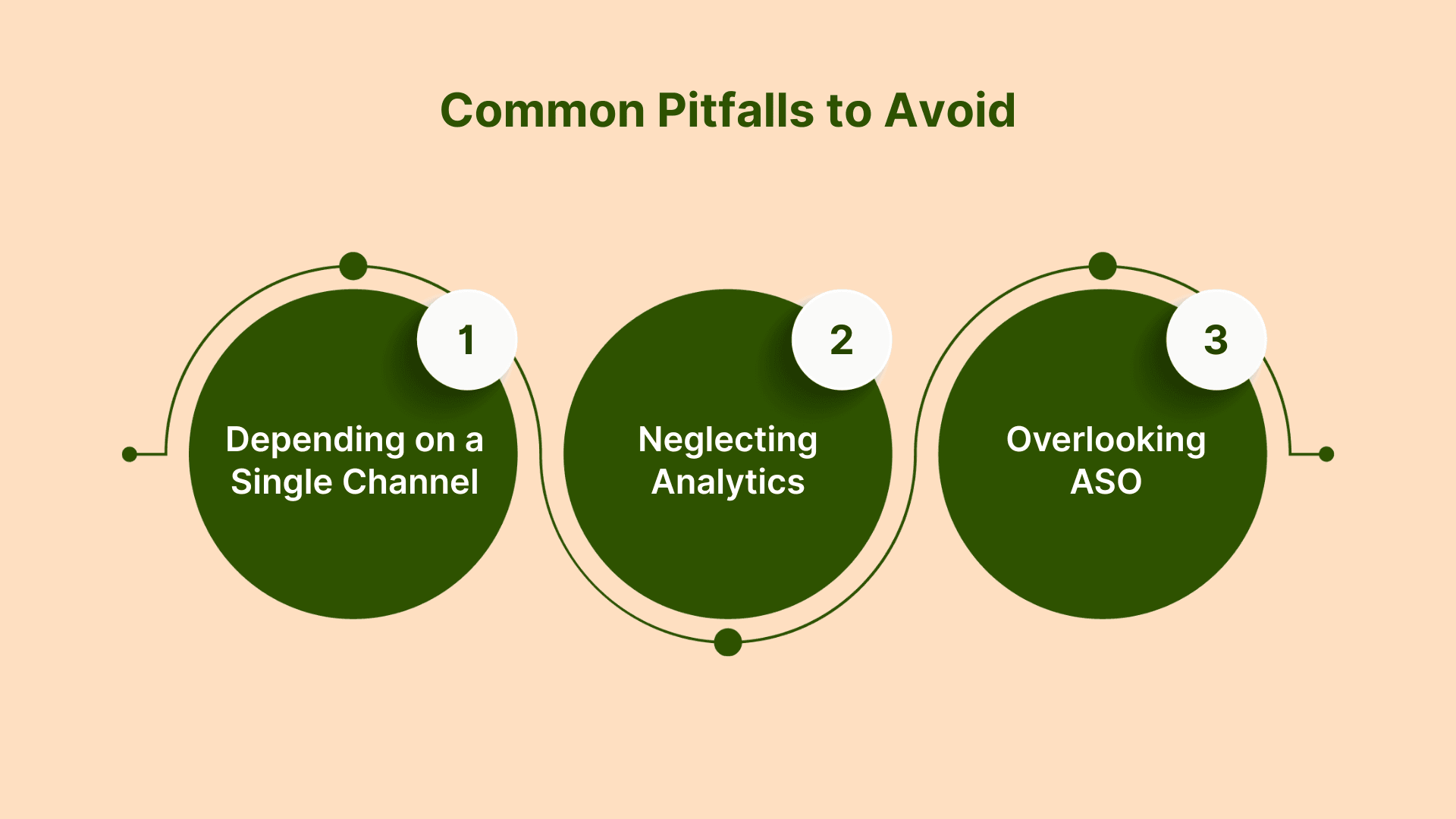Effective User Acquisition Strategies and Tips
Acquiring fresh users is crucial for the growth of your business. Without a solid user acquisition strategy, even the most engaging games can go unnoticed. Understanding and implementing effective acquisition tactics can make the difference between a game that thrives and one that fades into obscurity.
If you're facing challenges like high user acquisition costs, low conversion rates, or difficulty scaling your player base, you're not alone. Many developers encounter these hurdles, but with the right strategies in place, you can turn things around and effectively grow your user base.
This blog explores proven strategies and actionable tips to help you overcome these obstacles and successfully acquire new players for your mobile game. By the end, you'll have a clear roadmap to optimize your user acquisition efforts.
What is User Acquisition in Mobile Gaming?

User acquisition in mobile gaming combines paid channels (e.g., social, search, display ads) and organic growth levers (such as ASO, community-building, and content marketing). Both are equally critical for scalable growth in 2025.
Why User Acquisition Matters
Improves Your Game’s Visibility: Acquiring installs, especially from high-intent sources, can enhance keyword rankings and visibility in app store algorithms, particularly when combined with strong retention and engagement metrics.
Gives You Actionable Player Insights: Tracking where your installs come from and how new users behave helps you spot what works best. Use cohort analysis to link acquisition channels with downstream retention and LTV, allowing more granular optimization. You can use those insights to refine your ad targeting, creative assets, and app‑store listings for even stronger user growth.
Builds an Engaged Player Base: Effective acquisition doesn’t stop at the install. When you target the right players and deliver on your marketing promise, they’re more likely to leave positive feedback, share with friends, and stick around, creating a community that fuels ongoing growth.
To successfully acquire new players, it’s essential to implement proven strategies that target the right audience and drive installs.
Effective User Acquisition Strategies
Start your UA efforts by focusing on channels and tactics that put your game in front of the right players. Below are seven proven strategies you can use to boost installs and engagement:

1. Drive High‑Intent Installs via Apple Search Ads + Custom Product Pages
Reach users actively searching for games like yours by bidding on high‑value keywords. Utilize up to 35 Custom Product Pages (CPPs) on the App Store, each with unique visuals, promotional text, and deep links, to mirror ad messaging and keyword targeting for specific segments or campaigns. CPPs can significantly increase conversion rates and decrease CPI when continuously tested and iterated.
How to implement:
Segment by genre and player intent (e.g., “strategy gamers” vs. “casual players”).
Create matching CPPs with customized screenshots, icons, and CTAs.
Launch Apple Search Ads campaigns targeting those keywords.
Track day-1 and day-7 retention to measure CPP effectiveness.
Why it works: These ads directly connect user intent to segmented experiences, increasing conversion rates and improving App Store rankings through stronger install performance.
2. Optimize Creative Testing via Structured Google App Campaigns
Set up your app campaigns with a clear structure, separating them by platform and goal. For example, use one campaign optimized for iOS and another for Android. Within each campaign, leverage Google’s asset group structure to isolate variables and use AI/ML-powered creative testing tools for rapid generation and scoring of creative variants. Regularly refresh assets to prevent creative fatigue, and apply platform-specific testing frameworks for Google and alternative channels.
How to implement:
Segment campaigns for iOS installs, one for Android installs.
Within each campaign, build 2–4 asset groups focused on a single theme.
Upload diverse, high-quality assets across text, image, video, and HTML5 (up to 20 images/videos, four text lines, HTML5 for game demos).
Label campaigns and asset groups consistently for easier reporting and iteration.
Allow campaigns to gather statistically significant data (generally several hundred installs or more, depending on platform and target CPA/CPI) before optimization.
Track conversions with MMP or Firebase to ensure campaign optimization aligns with goals.
Review asset performance (using tags such as Low, Good, and Best), and pause or refresh underperformers every 2–3 weeks.
Why it works: This structured approach ensures Google's algorithm has a clean, comparable dataset, helping it learn what creative resonates best. That means faster optimization, higher install rates, and improved engagement, translating directly into better ROI. Continuous asset refresh prevents fatigue and keeps content fresh, maintaining long-term performance.
3. Enhance Organic Funnel Through ASO + A/B Testing
Treat ASO as a cyclical process of discovery, optimization, and measurement. Begin by understanding how players search for your game, then test high-impact visuals and metadata, and finally refine any elements that boost conversions or visibility. The goal is to turn every organic impression into an install and establish a performance feedback loop that continuously improves your store's presence.
How to Implement:
Keyword Research & Layering:
Use tools like AppTweak, Sensor Tower, or Play Console suggestions to identify mid-tier keywords (high volume and relatively low competition) relevant to your genre.
Map keywords across title, subtitle, and description fields and update them every quarter.
Creative A/B Testing:
Endorse the use of ongoing, cyclical A/B testing using store-specific native testing platforms (Google Play Store Listing Experiments; Apple’s Product Page Optimization). Mention using cross-tool results to validate findings.
Begin with a bold hypothesis—for example, "A vibrant, minimal icon will improve tap-through by 10%."
Iteration & Tracking:
Run tests 2–4 weeks, track conversion lift and keyword rank improvements.
Roll out winning variants store-wide and observe the impact on daily installs and retention.
Refresh creatives and metadata to avoid fatigue or trending decay.
Why it works: Continual A/B testing helps validate your assumptions: you learn precisely what design or wording resonates, avoiding guesswork. Better keyword placement ensures your game appears in more relevant searches, while creative tweaks highlight value quickly—together boosting visibility, increasing conversion rates, and lowering your organic cost-per-install.
4. Increase Conversion with Playable Ads
Convert passive video ads into immersive, interactive previews, allowing users to experience a taste of your game before installation. This hands-on demo showcases core mechanics, allowing players to “try before they buy,” which significantly improves ad performance.
The Segwise Free Video to Playable Ad Converter tool is a no-code, free conversion utility that transforms your existing MP4 video ads into fully functional playable ad units. With an intuitive drag-and-drop interface and support for AppLovin and Mintegral formats, it generates embeddable HTML5 snippets in under two minutes, eliminating the need for a development team.
Here is how Segwise converts video ads into playables:
Step 1: Upload to Video Ad Maker
Drop your MP4 video file into the Segwise interface. This is the base asset that will be converted into a playable ad format.Step 2: Choose Network & Build
Select your desired ad network (e.g., AppLovin, Mintegral). Segwise will automatically generate optimized playable ad code compatible with that platform.Step 3: Deploy Your Video Playables
Use the generated code to launch your playable ad directly on the selected network.
Why it works: Users exposed to playables experience a “test‑drive,” which raises conversion rates three times compared to videos and reduces CPI by eliminating casual clickers. Interactivity captures attention (20 times more than banners) and boosts retention (30–40%), as new installs already understand the game mechanics.
5. Build Buzz via Influencers & Short‑Form Video Collaborations
Partner with niche gaming creators across platforms like TikTok and YouTube Shorts to create authentic, engaging moments around your game. Focus on creators whose tone, audience, and content style align with your player personas. Let creators highlight real gameplay experiences, features, or challenges to drive interest organically.
How to Implement:
Shortlist micro and mid-tier creators whose followers overlap with your game’s target segment (genre, region, platform).
Give creators early access or exclusive content to generate “first look” videos or launch hype.
Encourage formats like gameplay walkthroughs, viral challenges, reactions, or countdowns.
Set up unique referral links, promo codes, or attribution tags to track installs and downstream actions.
Run A/B tests with different creators or platforms to evaluate performance by engagement and install quality.
Repurpose high-performing content into paid ads or store creatives for broader distribution.
Why it works: Influencer content drives peer trust, social proof, and organic search traction, delivering awareness and installs without overspending.
6. Stimulate Demand with Connected TV (CTV) + Mobile Pivot
Leverage programmatic CTV ads with cross-device attribution (via MMP, device graphing, or direct QR code tracking) to ensure proper campaign measurement. Utilize interactive CTV formats (e.g., QR codes, shoppable units) to encourage app installations. This dual-screen approach taps into viewers’ smartphone usage while watching, creating a seamless path from awareness to action.
How to Implement:
Craft engaging CTV ad creatives highlighting cinematic gameplay moments, high-impact visuals, and core mechanics.
Embed clear CTAs such as QR codes, “Scan to Download,” or spoken cues directing viewers to your app store page.
Set up measurement frameworks with attribution methods to capture cross-device installs, such as QR code scans and assisted-install tracking via MMP or device IP.
Plan controlled tests to run CTV ads in selected regions while leaving others as controls, then monitor install uplift both during and after the campaign.
Why it works: Viewers often use their phones while watching CTV, which makes it easier to convert impressions into installs. This cross-device behavior adds organic lift and helps reduce your average acquisition cost.
To further enhance your user acquisition campaigns, implementing a few tips can make a significant difference.
Also Read: Why Playable Ads Are Dominating Mobile UA And How You Can Win Big
Tips for Optimizing User Acquisition Efforts
When you want to attract more players to your mobile game, you need clear, practical tips that you can implement right away. Here are four proven ways to sharpen your UA gaming efforts:

Data-Driven Decisions: Track key metrics such as cost per install (CPI), lifetime value (LTV), and return on ad spend (ROAS) to determine what works best. CPI tells you how much you pay to get each new player, while LTV and ROAS show how much revenue those players bring back over time. By comparing these numbers, you can allocate the budget more effectively toward ad sets and channels that attract high-value users at a lower cost.
User Feedback: Let your players speak up and then use their ideas to improve the game. Check user reviews on the App Store or Google Play at least once a week and note common praise or complaints. You can also conduct surveys or community polls to gather direct suggestions.
Continuous Testing: Never settle on a single acquisition channel or ad creative. Experiment with different ad formats and audience segments alongside your live campaigns to compare performance. This lets you A/B test new visuals, copy, or targeting options without risking your core budget. Over time, you’ll find which variations drive the best installs and scale them up.
Localization: Don’t run a one-size-fits-all ad. Translate your ad copy, swap in region-specific graphics, and adjust cultural references accordingly. Use Google’s asset grouping to upload multiple language versions. Localized ads feel native to players and significantly increase the number of installs.
To ensure your user acquisition strategy remains effective, it's equally important to recognize and avoid common mistakes.
Also Read: A Beginner's Guide to A/B Testing Ads for Optimization
Common Pitfalls to Avoid

Before launching your user acquisition campaigns, be aware of these three common missteps. Overlooking any of them can slow your momentum and eat into your budget:
Depending on a Single Channel: Don’t funnel your entire budget into a single ad channel. When you diversify across different networks and organic outreach, you broaden your reach, reduce risk, and uncover new player segments.
Neglecting Analytics: If you skip regular review of your campaign metrics, like install rates or cost per player, you can’t tell what’s driving growth. Regularly review your performance data and adjust your bids, creatives, or audience segments accordingly based on these results.
Overlooking App Store Optimization (ASO): A well-crafted game page is crucial for converting ad clicks into installs. Ensure that your title, description, keywords, and visuals are all optimized and regularly updated to maintain optimal performance. A strong listing enhances your game's organic visibility.
Conclusion
Effective user acquisition is pivotal for the growth of your mobile game. By implementing user acquisition strategies, you can enhance visibility and attract the right audience. Continuous testing and adaptation to player preferences ensure sustained engagement and long-term success.
To streamline and optimize your user acquisition process, consider utilizing Segwise's AI-powered platform. Segwise offers an automated AI creative agent and campaign monitoring agent to tag high-performing creatives and make data-driven decisions. By integrating Segwise into your workflow, you can save time, reduce manual efforts, and improve your return on ad spend.
So, are you ready to elevate your user acquisition strategy? Try our 14-day free trial today and experience firsthand how our AI-driven insights can transform your ad performance.
FAQs
1. How Important Is A/B Testing in UA?
A/B testing allows you to compare different versions of ads, landing pages, or in-game features to determine which performs better. This data-driven approach helps refine strategies and improve user acquisition outcomes.
2. How can I identify the most effective user acquisition channels for my mobile game?
Begin by analyzing your target audience's behavior and preferences. Utilize analytics tools to track where your installs are coming from and which channels yield the highest return on investment. Experiment with various platforms, such as Facebook, Instagram, TikTok, and Google Ads, to determine which ones resonate most effectively with your audience.
3. How can community building impact user acquisition?
Establishing a community around your game fosters loyalty and promotes word-of-mouth. Platforms like Discord and Reddit enable direct interaction with players, gathering feedback, and creating a sense of belonging, which can drive organic growth.
4. How can I stay updated with the latest trends in user acquisition?
Regularly following industry blogs, attending webinars, and participating in developer communities can keep you informed about the latest tools, strategies, and best practices in user acquisition.
5. How can user-generated content (UGC) enhance acquisition?
Encouraging users to share reviews, testimonials, social posts, or running contests boosts credibility and organic reach. UGC builds trust more quickly than brand messaging, with 85% of consumers trusting it more than traditional advertisements.

Comments
Your comment has been submitted successfully!